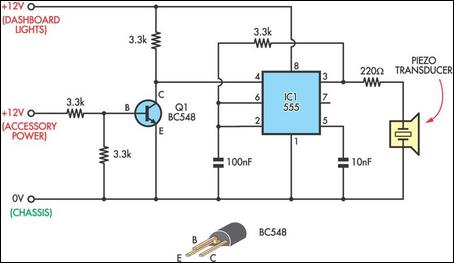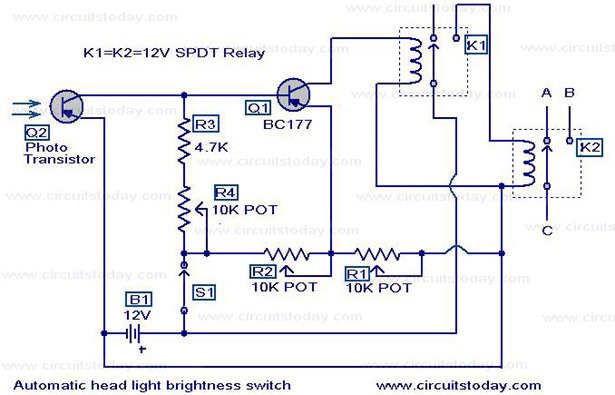
headlight reminder schematics

With the storm season recently upon us, it is common to switch car headlights on during the daytime. Unfortunately, it is easy to forget to turn them off again when parking, resulting in a flat battery. This circuit will sound an alarm if the ignition switch is moved to the "off" position while the car lights are on, reminding the user to turn the lights off before leaving the vehicle. The circuit is simple but effective. A 555 timer (IC1) is configured as a free-running oscillator to drive a small piezo transducer. The pitch of the transducer is set by the resistor and capacitor connected to pins 2 and 6. Power for the 555 is derived from the dashboard lighting circuit. However, the piezo does not sound during normal operation because the 555's reset input (pin 4) is held low by transistor Q1. This transistor is switched on whenever accessory power is present, pulling its collector towards ground (0V). If the ignition is switched off but the lighting circuit remains powered, the loss of accessory power results in Q1 switching off and releasing the reset signal to IC1, sounding the alarm. A 220-ohm resistor in series with the piezo protects the 555's output (pin 3). Although most piezo elements have relatively high impedance, this drops as the frequency increases due to their capacitive nature. The square-wave output on pin 3 includes many harmonics, some extending well into the ultrasonic range. The unit fits easily into a small plastic box. The circuit can be integrated into the wiring running to the cigarette lighter, which includes both accessories and panel lamp circuits as well as a chassis ground wire. The result fits neatly behind the ashtray, with no chassis modifications required.
This circuit utilizes a 555 timer integrated circuit (IC1) configured in astable mode to generate a continuous square wave signal, which drives a piezoelectric transducer for audible alerts. The configuration of the 555 timer is crucial for ensuring the alarm functions correctly. The timing components, specifically the resistor and capacitor connected to pins 2 and 6, determine the frequency of the oscillation, which in turn affects the pitch of the sound produced by the piezo transducer.
Transistor Q1 plays a significant role in the operation of the circuit by controlling the reset pin (pin 4) of the 555 timer. When the vehicle's ignition is in the "on" position, Q1 is activated, keeping the reset pin low and preventing the timer from oscillating. This ensures that the piezo does not emit sound during normal operation. The moment the ignition is turned off, Q1 deactivates, allowing the reset pin to go high and enabling the timer to oscillate, thus sounding the alarm.
The inclusion of a 220-ohm resistor in series with the piezo transducer is a protective measure for the 555 output. This resistor limits the current flowing into the piezo, safeguarding the timer from potential damage due to excessive load. The piezo transducer, while typically having a high impedance, can exhibit lower impedance at higher frequencies due to its capacitive properties. This aspect is important when designing the circuit to ensure that the 555 timer can effectively drive the piezo without overloading.
The circuit can be conveniently housed in a compact plastic enclosure, making it suitable for installation in various locations within the vehicle. By integrating it with the wiring harness connected to the cigarette lighter, the circuit can easily access both accessory power and the dashboard lighting circuit, facilitating straightforward installation without the need for extensive modifications to the vehicle’s electrical system. The final assembly can be discreetly placed behind the ashtray, maintaining the aesthetics of the vehicle’s interior while providing an essential alert system to prevent battery drain.With the storm season recently upon us, it`s not uncommon to switch car headlights on during the daytime. Unfortunately, it`s easy to forget to turn them off again when parking, with the result being a flat battery.
This circuit will sound an alarm if the ignition switch is moved to the "off" position while the car lights are on, reminding you to turn the lights off before leaving the vehicle. The circuit is simple but effective. A 555 timer (IC1) is configured as a free-running oscillator to drive a small piezo transducer. The pitch of the transducer is set by the resistor and capacitor connected to pins 2 & 6. Power for the 555 is derived from the dashboard lighting circuit. However, the piezo does not sound during normal operation, because the 555`s reset input (pin 4) is held low by transistor Q1. This transistor is switched on whenever accessory power is present, pulling its collector towards ground (0V).
If the ignition is switched off but the lighting circuit remains powered, the loss of accessory power results in Q1 switching off and releasing the reset signal to IC1, sounding the alarm. A 220 © resistor in series with the piezo protects the 555`s output (pin 3). Although most piezo elements have relatively high impedance, this drops as the frequency increases due to their capacitive nature.
The square-wave output on pin 3 includes many harmonics, some extending well into the ultrasonic range. The unit fits easily into a small plastic box. I spliced mine into the wiring running to the cigarette lighter, which includes both accessories and panel lamp circuits as well as a chassis ground wire.
The result fits neatly behind the ashtray, with no chassis bashing required! 🔗 External reference
This circuit utilizes a 555 timer integrated circuit (IC1) configured in astable mode to generate a continuous square wave signal, which drives a piezoelectric transducer for audible alerts. The configuration of the 555 timer is crucial for ensuring the alarm functions correctly. The timing components, specifically the resistor and capacitor connected to pins 2 and 6, determine the frequency of the oscillation, which in turn affects the pitch of the sound produced by the piezo transducer.
Transistor Q1 plays a significant role in the operation of the circuit by controlling the reset pin (pin 4) of the 555 timer. When the vehicle's ignition is in the "on" position, Q1 is activated, keeping the reset pin low and preventing the timer from oscillating. This ensures that the piezo does not emit sound during normal operation. The moment the ignition is turned off, Q1 deactivates, allowing the reset pin to go high and enabling the timer to oscillate, thus sounding the alarm.
The inclusion of a 220-ohm resistor in series with the piezo transducer is a protective measure for the 555 output. This resistor limits the current flowing into the piezo, safeguarding the timer from potential damage due to excessive load. The piezo transducer, while typically having a high impedance, can exhibit lower impedance at higher frequencies due to its capacitive properties. This aspect is important when designing the circuit to ensure that the 555 timer can effectively drive the piezo without overloading.
The circuit can be conveniently housed in a compact plastic enclosure, making it suitable for installation in various locations within the vehicle. By integrating it with the wiring harness connected to the cigarette lighter, the circuit can easily access both accessory power and the dashboard lighting circuit, facilitating straightforward installation without the need for extensive modifications to the vehicle’s electrical system. The final assembly can be discreetly placed behind the ashtray, maintaining the aesthetics of the vehicle’s interior while providing an essential alert system to prevent battery drain.With the storm season recently upon us, it`s not uncommon to switch car headlights on during the daytime. Unfortunately, it`s easy to forget to turn them off again when parking, with the result being a flat battery.
This circuit will sound an alarm if the ignition switch is moved to the "off" position while the car lights are on, reminding you to turn the lights off before leaving the vehicle. The circuit is simple but effective. A 555 timer (IC1) is configured as a free-running oscillator to drive a small piezo transducer. The pitch of the transducer is set by the resistor and capacitor connected to pins 2 & 6. Power for the 555 is derived from the dashboard lighting circuit. However, the piezo does not sound during normal operation, because the 555`s reset input (pin 4) is held low by transistor Q1. This transistor is switched on whenever accessory power is present, pulling its collector towards ground (0V).
If the ignition is switched off but the lighting circuit remains powered, the loss of accessory power results in Q1 switching off and releasing the reset signal to IC1, sounding the alarm. A 220 © resistor in series with the piezo protects the 555`s output (pin 3). Although most piezo elements have relatively high impedance, this drops as the frequency increases due to their capacitive nature.
The square-wave output on pin 3 includes many harmonics, some extending well into the ultrasonic range. The unit fits easily into a small plastic box. I spliced mine into the wiring running to the cigarette lighter, which includes both accessories and panel lamp circuits as well as a chassis ground wire.
The result fits neatly behind the ashtray, with no chassis bashing required! 🔗 External reference





